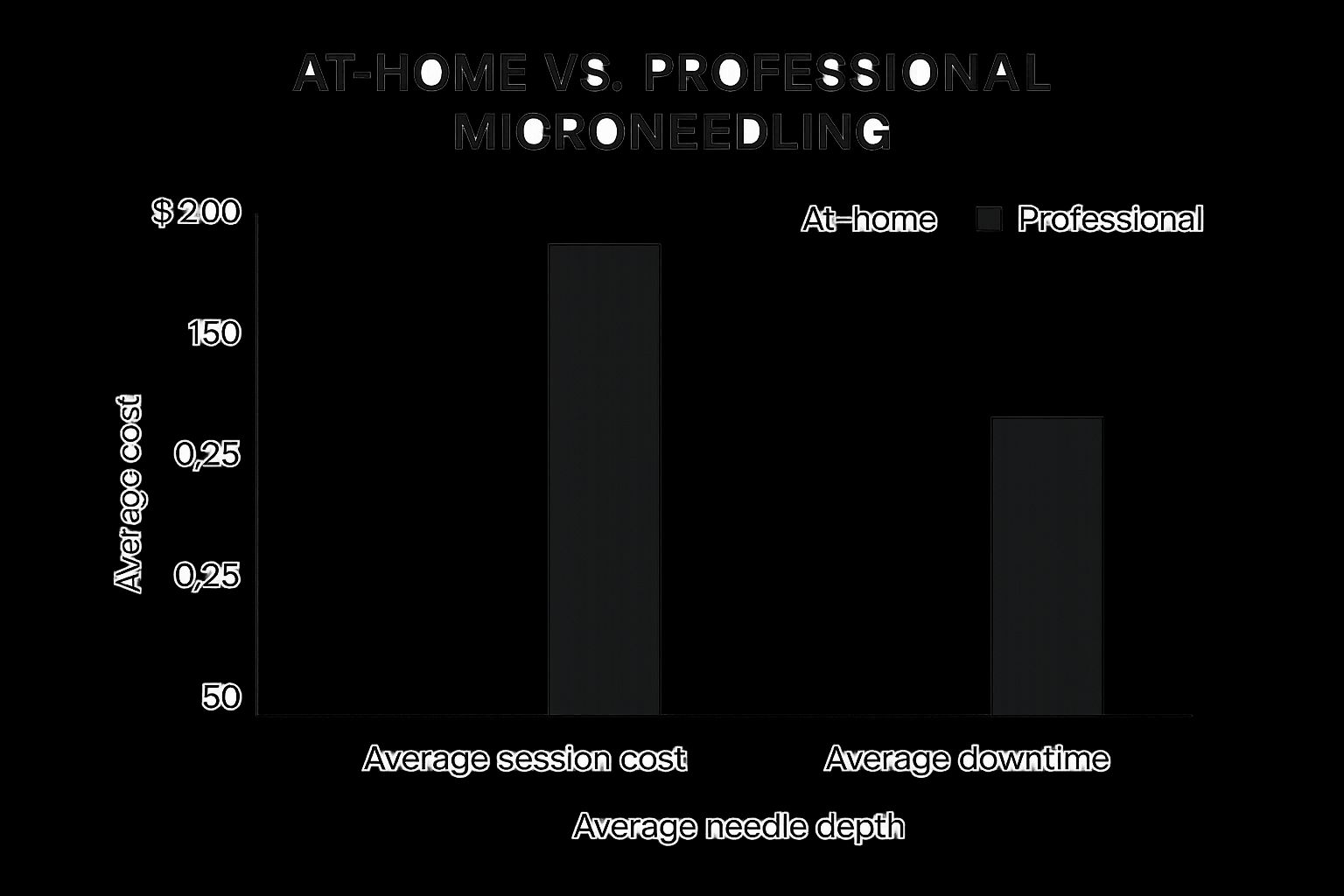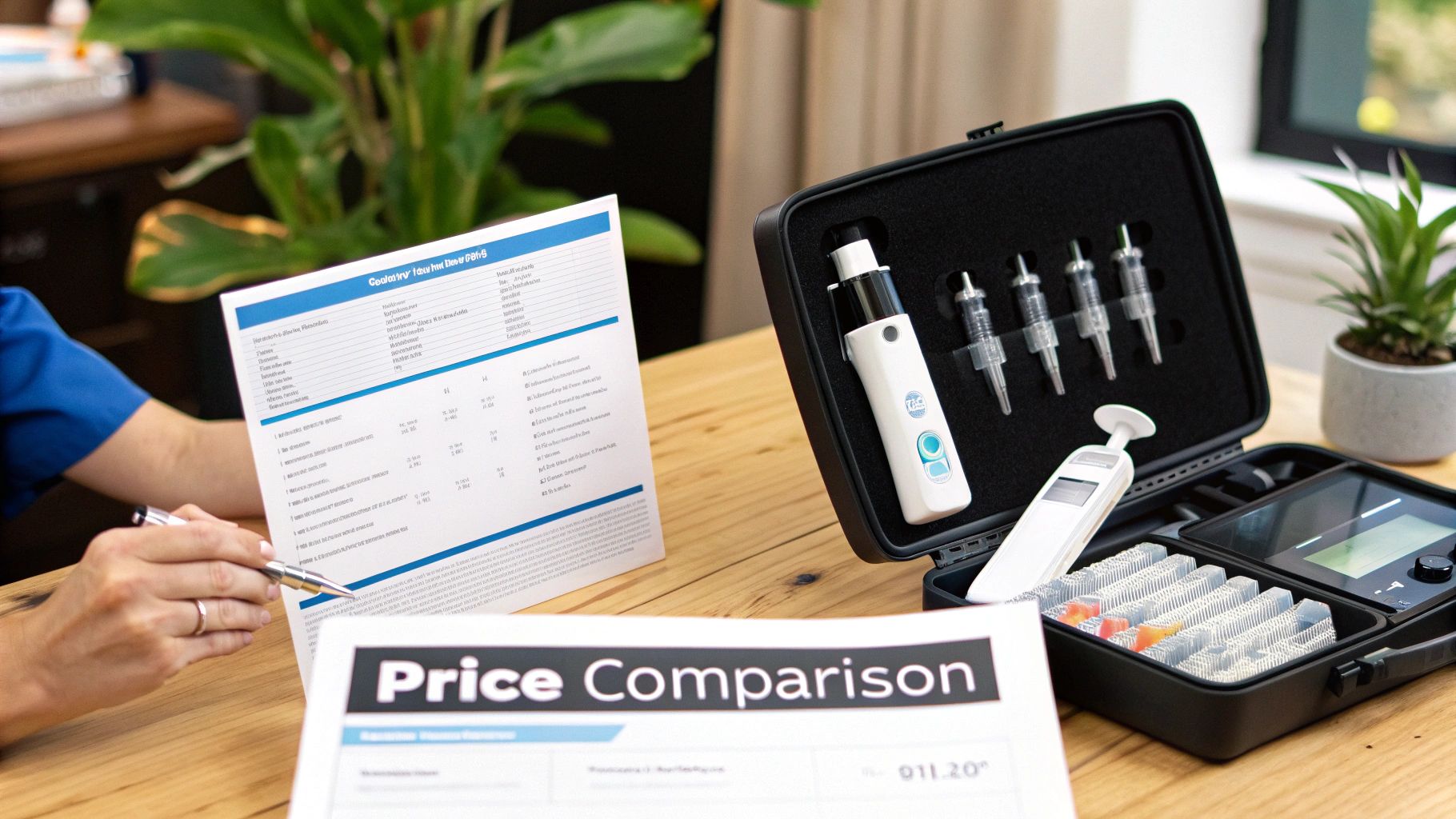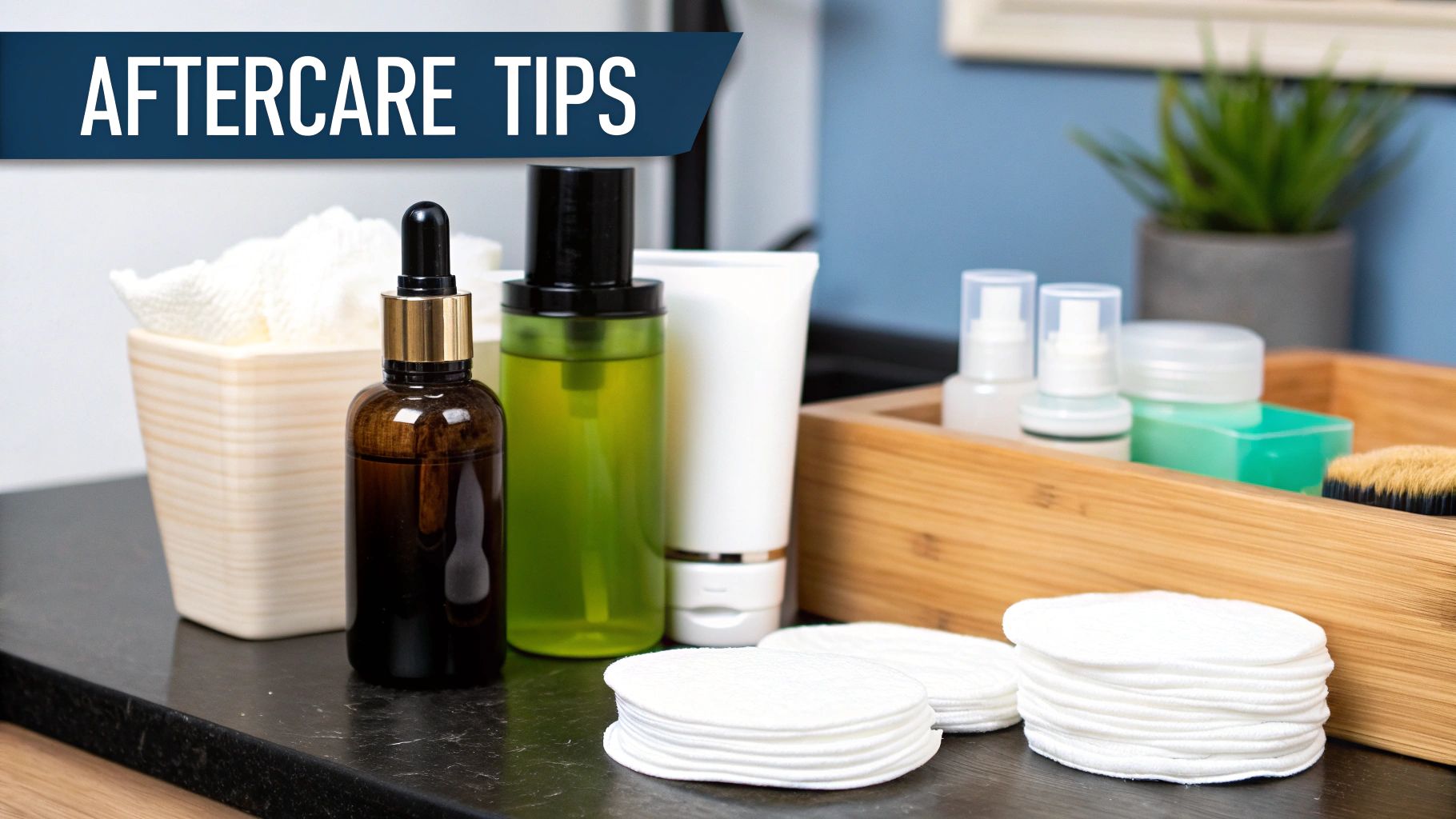
Microneedling at Home vs Professional: Which Delivers Better Results?
The Microneedling Reality Check: What Industry Insiders Won't Tell You
The rising popularity of microneedling brings both opportunity and confusion. Marketing buzzwords can easily cloud the real differences between at-home and professional treatments. It’s less about comparing surface features and more about understanding the core principles that drive results—and the inherent limitations of each method. For example, the idea that deeper penetration is always better isn’t always accurate.
Professional microneedling uses longer needles to reach deeper skin layers. At-home devices, however, have shorter needles, a necessary safety precaution. This limitation directly affects outcomes. Deeper penetration stimulates more collagen and elastin production, effectively targeting deep wrinkles and acne scars. At-home devices, with their shallower reach, are better suited for superficial improvements like texture refinement and boosting product absorption. This recent boom in the microneedling market, fueled by technological advancements and a growing interest in skincare, presents a challenge for consumers deciding between at-home and professional treatments. Learn more about microneedling trends. Understanding these fundamental differences is key to managing expectations.
Another crucial, yet often ignored, element is technique. Licensed practitioners receive extensive training in needle depth, pressure, and speed, maximizing results and minimizing risk. Replicating this level of precision at home is challenging, even with detailed instructions. Professionals can also customize treatments based on your unique skin type and concerns. At-home microneedling, by design, takes a more generalized approach. This personalized expertise makes a significant difference, especially when addressing complex skin issues.
Finally, a rarely discussed "insider secret" is the commitment needed for optimal results. At-home microneedling is convenient, but consistency is paramount. Maintaining a regular routine requires discipline. Professional treatments, while requiring fewer sessions, entail scheduling, travel, and potentially higher upfront costs. The best approach isn’t about convenience or cost alone; it’s the one you can realistically maintain to achieve your desired outcome. Choosing wisely requires honestly evaluating your commitment.
The Depth Dilemma: Why Needle Length Determines Your Results

The key difference between at-home and professional microneedling treatments comes down to needle length. This seemingly minor detail has a significant impact on the results you can achieve. Effective microneedling isn't about randomly creating punctures; it's about precision and targeting specific depths to stimulate the optimal healing response.
Understanding Depth and Collagen Stimulation
Think of your skin as having distinct layers. The outermost layer, the epidermis, is relatively thin. At-home microneedling devices, with needles typically shorter than 0.5mm, mainly work within this surface layer. This makes them generally safe for self-use, but it also limits their impact on collagen production.
The real magic happens deeper down, in the dermis. This is where collagen and elastin, the building blocks of youthful skin, are synthesized. Professional microneedling treatments, using needles from 1mm to 3mm, reach this critical layer to promote substantial skin remodeling. The deeper penetration creates more pronounced micro-injuries, triggering a more robust healing process that can lead to visible improvements in skin texture, scarring, and wrinkles. Professional devices typically use these longer needles (1mm to 3mm) to create microscopic injuries that stimulate the growth factors essential for collagen and elastin formation. At-home devices, like dermarollers or pens, often have needles less than 1mm, leading to only superficial micro-injuries that are insufficient for significant skin remodeling. Discover more insights on needle length and its impact on microneedling.
Why Deeper Isn't Always Better at Home
While deeper needle penetration generally yields more dramatic results, it also carries increased risks. The chances of complications, such as scarring or infection, rise with needle length. That's why longer needles are best left in the hands of trained professionals who understand how to minimize these potential issues.
Matching Depth to Your Goals
Deciding between at-home and professional microneedling hinges on your individual goals. If you’re looking for superficial benefits like enhanced product absorption and minor texture refinement, an at-home device might be sufficient. But if you’re hoping to address deeper wrinkles, acne scars, or more pronounced texture concerns, the depth achieved with professional treatments is often necessary.
Understanding the relationship between needle depth and results allows you to make informed decisions about the best approach for you. It’s about matching your chosen method to your specific skincare objectives.
What Actually Happens To Your Skin: Real Results Beyond The Hype
Let's discuss the real-world outcomes of microneedling, separating genuine skin improvements from marketing exaggerations. At-home microneedling typically delivers subtle enhancements to skin texture and improves the absorption of your skincare products. This makes it a good option for maintaining a healthy complexion and targeting minor imperfections.
However, the shallow needle depth of at-home devices limits their effectiveness on deeper skin concerns like deep wrinkles or acne scars. You might see a slight improvement in overall skin tone or a mild reduction in fine lines, but expecting a dramatic transformation isn't realistic.
Professional Microneedling: Deeper Impact
Professional microneedling, performed by a licensed esthetician or dermatologist, works at a deeper level. The longer needles penetrate the dermis, stimulating significant collagen and elastin production. This results in more noticeable improvements in acne scars, deeper wrinkles, and skin laxity. While at-home treatments might offer gradual refinement, professional sessions provide more substantial transformations. For a visual comparison, see these microneedling before and after results.

As the infographic above highlights, professional treatments come with a higher price tag. However, they offer a significantly greater needle depth, leading to more pronounced results. The increased downtime after a professional treatment reflects the more intensive nature of the procedure.
Treatment Outcomes and Timelines
To understand the differences in outcomes and timelines, let's consider a few common skin concerns. The table below summarizes the expected results and timelines for both at-home and professional microneedling:
Treatment Outcomes Comparison: At-Home vs Professional Results
Side-by-side analysis of expected results, timeline, and effectiveness for common skin concerns
Skin Concern At-Home Results Professional Results Timeline Difference Fine Lines Mild reduction, mainly superficial Noticeable smoothing, improvement in deeper lines Professional results appear more quickly and are more dramatic Skin Texture Slight improvement, smoother feel Significant improvement, refined pores, reduced roughness Professional treatments yield faster and more substantial changes Acne Scars Minimal improvement, may help with surface irregularities Noticeable reduction in scar depth and appearance, improved texture Professional results are more significant and take several months to fully manifest Skin Tone Mild brightening, slight improvement in hyperpigmentation More even skin tone, reduced hyperpigmentation, brighter complexion Professional treatments provide faster and more visible improvements
The table clearly shows that while at-home microneedling might offer some benefits, professional treatments offer more significant and faster results for most skin concerns. The timeline for visible results also differs considerably. At-home methods, with their focus on surface-level changes, might produce subtle improvements within a few weeks.
However, substantial collagen remodeling requires time. Professional microneedling, though it kickstarts the process more intensely, still requires several months for the full effects to become apparent. This is because the body's natural collagen production cycle is a gradual one. Patience and consistent treatments are essential, regardless of your chosen method.
Ultimately, understanding these subtle but important distinctions helps you make an informed decision tailored to your individual skincare goals and expectations.
The Safety Reality: Understanding Actual Risks Vs. Fear-Based Marketing

Safety is a paramount concern with microneedling, regardless of whether you choose at-home or professional treatment. Often, discussions tend to fixate on worst-case scenarios, amplifying anxieties. But a clear understanding of the actual risks, separated from the marketing hype, empowers you to make a truly informed choice.
At-Home Microneedling: Real Risks
The biggest risk with at-home microneedling is infection, primarily due to inadequate device sterilization. Shorter needles, the standard for at-home devices, minimize deeper skin damage. However, neglecting proper cleaning introduces bacteria, setting the stage for potential skin infections. Scarring, while less common with shorter needles, is another potential risk. Excessive pressure or repeatedly needling the same area can cause micro-tears, sometimes leading to scarring.
Professional Microneedling: Minimizing Risks
Professional treatments dramatically reduce these risks. Licensed practitioners operate in sterile environments, adhering to medical-grade sterilization protocols. Their training emphasizes proper technique, mitigating the chances of scarring or other adverse effects. Individuals dealing with acne scars might find valuable insights from resources like this post on microneedling for acne scars. Moreover, professionals customize treatment depth and needle type to your unique skin and concerns, further minimizing risk.
Skin Type and Existing Conditions
Your skin type plays a crucial role in safety considerations. Those with sensitive skin or existing conditions like rosacea or eczema are more prone to irritation and inflammation with at-home microneedling. Professional guidance becomes paramount in these cases, allowing the practitioner to carefully determine the appropriate treatment parameters and reduce the risk of aggravating existing issues.
Medications and Safety Considerations
Certain medications, such as blood thinners and retinoids, can increase bleeding or bruising during microneedling. Disclosing all current medications to your practitioner before a professional treatment is vital. For at-home microneedling, a pre-treatment consultation with a dermatologist or aesthetician is critical to assess safety based on your medication regimen.
Distinguishing Fear from Fact
Much of the fear surrounding microneedling stems from misconceptions about the procedure itself. The thought of needles piercing the skin can be unsettling. However, performed correctly, with the right needle lengths and sterile techniques, microneedling is a safe and effective treatment. Focus on understanding the actual risks, rather than dwelling on extreme scenarios. Ultimately, a balanced approach based on your personal risk factors – skin type, current conditions, and commitment to proper technique – allows you to confidently choose the best microneedling path for you.
The True Cost Analysis: Beyond Sticker Prices To Real Value
When weighing up at-home versus professional microneedling, the initial price tag often catches the eye. At-home devices seem appealing with upfront costs typically ranging from $20 to $200. But, this is just the tip of the iceberg.
These devices rely on replacement needle cartridges, adding to the long-term expense. Plus, maximizing results and aiding healing at home often involves complementary products like hyaluronic acid or vitamin C serums. These recurring costs can quickly add up.
Professional sessions, while pricier upfront ($200 to $700 per session, depending on location and device) frequently bundle these extras into the treatment package. Learn more about the cost comparison of microneedling treatments. This makes a direct cost comparison more complex.
Considering The Value Of Your Time
Beyond product costs, consider your time. At-home treatments demand time for setup, sterilization, the procedure itself, and meticulous aftercare. Professional sessions, while requiring appointment time, relieve you of these responsibilities. Factoring in the value of your time significantly impacts the cost equation.
Treatment Frequency and Long-Term Costs
At-home microneedling, with its shallower penetration, usually requires more frequent treatments to achieve and maintain results. Professional treatments, reaching deeper skin layers, often deliver more noticeable results with fewer sessions. This difference in frequency can drastically alter the overall cost over time.
Let's illustrate the cost differences over a year. The following table breaks down the potential investment for both at-home and professional microneedling over a 12-month period.
Total Cost Analysis: First Year Investment Comparison Comprehensive breakdown of all costs associated with each approach over 12 months
Cost Category At-Home Investment Professional Investment Notes Device $50 - $200 N/A One-time purchase for at-home; included in professional sessions Needle Cartridges $60 - $180 Included Assuming monthly cartridge changes for at-home Serums & Topicals $120 - $360 Included Estimated annual cost for at-home aftercare Professional Sessions N/A $2400 - $8400 Assuming 4-6 sessions per year at an average of $200 - $700/session Total Estimated Annual Cost $230 - $740 $2400 - $8400 Significant range depending on product choices and professional service provider.
As the table shows, while the initial outlay for at-home devices seems smaller, the yearly costs can add up. Professional treatments, while having a higher initial per-session cost, often include necessary extras and may require fewer sessions overall.
The Expertise Factor
Finally, the value of a skilled practitioner cannot be overstated. Their expertise in skin anatomy, treatment protocols, and potential complications contributes significantly to both safety and efficacy. This translates to potentially better results and possibly fewer sessions to achieve your desired outcome. In the long run, this professional guidance might offer a higher return on investment, despite the higher initial cost.
Your Personal Decision Framework: Finding The Right Approach

This screenshot from the American Academy of Dermatology website highlights potential risks and side effects associated with microneedling. It serves as a stark reminder of the importance of understanding these potential complications and emphasizes why a consultation with a dermatologist, particularly before at-home treatments, is so crucial for risk mitigation.
Deciding between at-home and professional microneedling is a deeply personal process. It requires careful consideration of individual needs, priorities, and circumstances. There is no universal solution. The ideal approach recognizes that a perfect fit for one person may be entirely inappropriate for another.
Defining Your Skin Goals and Priorities
Start by honestly evaluating your skincare goals. What are you hoping to achieve? Are you focused on minimizing fine lines, reducing acne scarring, improving overall skin texture, or perhaps simply enhancing product absorption? The severity of your concerns and your desired outcome play a significant role in determining the most effective path forward. Superficial imperfections like minor texture irregularities might respond well to the convenience of at-home microneedling. However, more significant issues like deep wrinkles or pronounced acne scars typically demand the precision and deeper penetration of professional treatments. For a deeper understanding of microneedling variations, this blog category on microneedling offers valuable insights.
Lifestyle, Risk Tolerance, and Budget
Beyond skincare goals, practical considerations like lifestyle, risk tolerance, and budget also heavily influence the decision-making process. At-home microneedling presents an appealing option for busy individuals or those on a tighter budget, offering convenience and potentially lower costs. However, it also requires discipline and unwavering attention to hygiene to minimize the risk of infection. Professional treatments, while generally more expensive, provide expert guidance and a controlled environment, significantly reducing potential complications. Professional microneedling is generally suitable for all skin types and tones, with trained practitioners carefully evaluating each patient’s unique skin condition to personalize treatment and maximize both safety and effectiveness. For a more in-depth look at professional microneedling suitability, discover more insights here.
Real-World Scenarios: How Individual Needs Influence Choice
Let's illustrate this with some practical examples. Imagine a busy professional seeking maximum efficiency for fine line reduction. This individual might find the focused expertise of professional sessions more aligned with their lifestyle. Contrast this with a skincare enthusiast comfortable with the at-home process and aiming for subtle texture improvement. This person might opt for the control and flexibility of an at-home device. Finally, consider someone with deeper acne scarring looking for substantial correction. In this scenario, the advanced techniques and deeper penetration offered by professional treatments would likely yield the most significant improvements.
Combination and Hybrid Strategies: Adapting as Your Needs Evolve
It's important to remember that your microneedling journey isn’t a one-time decision. You can start with at-home treatments for general skin maintenance and periodically integrate professional sessions for more intensive rejuvenation or targeted scar reduction. This hybrid approach allows you to enjoy the everyday convenience of at-home care while leveraging the enhanced efficacy of professional expertise when needed. As your skin changes over time or your goals evolve, your chosen methods can adapt accordingly. This flexibility empowers you with the right tools and techniques to consistently achieve your desired results.
Your Next Steps: From Decision To Implementation
Now that we’ve explored the intricacies of at-home versus professional microneedling, let’s map out a plan. This roadmap will guide you whether you’re leaning towards professional treatments, at-home devices, or still haven't made up your mind.
Choosing a Professional: Key Considerations
Finding the right professional takes more than just scanning online reviews. Begin by searching for practitioners with specific microneedling certifications and a proven track record. Ask about the devices they employ, their sterilization practices, and how they tailor individualized treatment plans. Don’t hesitate to discuss their experience addressing your specific skin concerns. A comprehensive consultation should fully explore your needs and desired outcomes.
Investing in At-Home Devices: Essential Checks
If at-home microneedling appeals to you, device quality and needle material should be your top priorities. Research respected brands known for their safety and efficacy. Make sure the device is easily sterilized and comes with clear instructions. Adjustable needle depths, allowing you to customize treatment for different areas, are another important feature. Investing in a high-quality device, while potentially a larger upfront cost, offers better long-term value and minimizes risk.
Questions To Ask Before Committing
Regardless of your chosen route, asking the right questions is paramount. If you're considering professional treatments, inquire about the overall cost, including any required follow-up appointments or suggested products. For at-home devices, understand the cost of replacement needles and the recommended usage frequency. In both scenarios, discuss potential side effects, recovery time, and realistic expectations for visible results. Being prepared for these practicalities makes for a smoother, more satisfying experience.
Setting Yourself Up for Success: Preparation and Aftercare
Proper preparation and aftercare are critical for both methods. Before any microneedling session, thoroughly cleanse your skin and avoid applying active ingredients such as retinoids or exfoliants. After treatment, diligently follow the recommended aftercare instructions. This usually involves using gentle, hydrating products and protecting your skin from sun exposure. Consistently following these guidelines optimizes results and minimizes potential issues.
Tracking Your Progress: Documenting Your Journey
Finally, document your journey. Photograph your skin before your first treatment and at regular intervals thereafter. This visual record allows you to monitor changes and provides valuable information for adjusting your approach. Take note of any improvements in skin texture, tone, or the reduction of scars and wrinkles. Consistent documentation helps ensure you're progressing toward your goals and lets you refine your strategy as needed.
Ready to unlock the benefits of microneedling? Olive Skin Therapy offers personalized treatments and expert guidance for achieving radiant, healthy skin. Book your consultation today!
